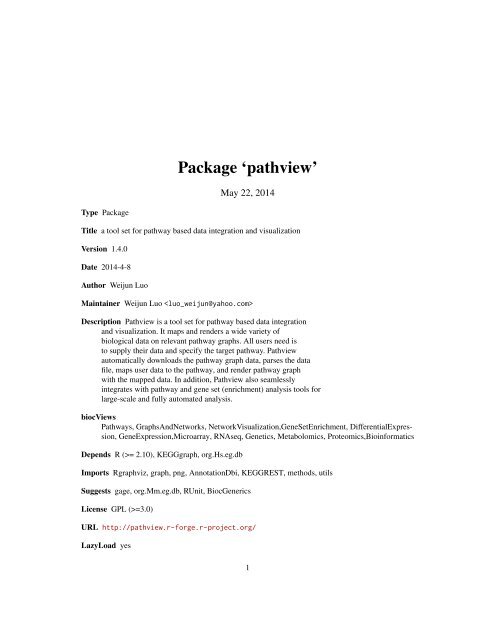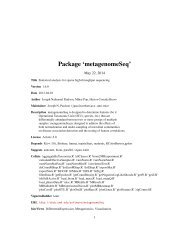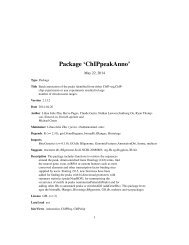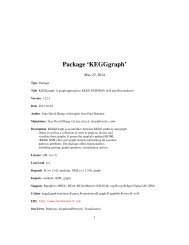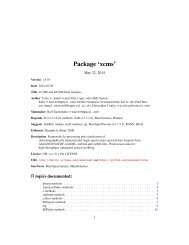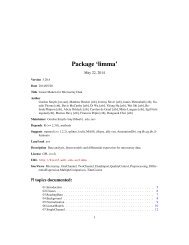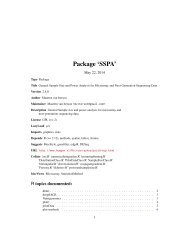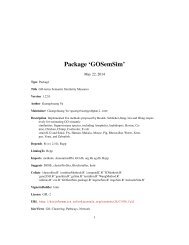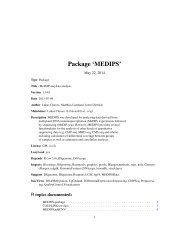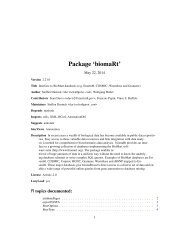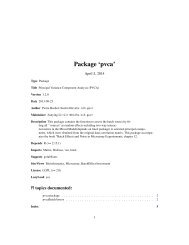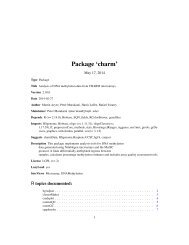Package 'pathview' - Bioconductor
Package 'pathview' - Bioconductor
Package 'pathview' - Bioconductor
You also want an ePaper? Increase the reach of your titles
YUMPU automatically turns print PDFs into web optimized ePapers that Google loves.
<strong>Package</strong> ‘pathview’May 22, 2014Type <strong>Package</strong>Title a tool set for pathway based data integration and visualizationVersion 1.4.0Date 2014-4-8Author Weijun LuoMaintainer Weijun Luo Description Pathview is a tool set for pathway based data integrationand visualization. It maps and renders a wide variety ofbiological data on relevant pathway graphs. All users need isto supply their data and specify the target pathway. Pathviewautomatically downloads the pathway graph data, parses the datafile, maps user data to the pathway, and render pathway graphwith the mapped data. In addition, Pathview also seamlesslyintegrates with pathway and gene set (enrichment) analysis tools forlarge-scale and fully automated analysis.biocViewsPathways, GraphsAndNetworks, NetworkVisualization,GeneSetEnrichment, DifferentialExpression,GeneExpression,Microarray, RNAseq, Genetics, Metabolomics, Proteomics,BioinformaticsDepends R (>= 2.10), KEGGgraph, org.Hs.eg.dbImports Rgraphviz, graph, png, AnnotationDbi, KEGGREST, methods, utilsSuggests gage, org.Mm.eg.db, RUnit, BiocGenericsLicense GPL (>=3.0)URL http://pathview.r-forge.r-project.org/LazyLoad yes1
2 pathview-packageR topics documented:pathview-package . . . . . . . . . . . . . . . . . . . . . . . . . . . . . . . . . . . . . . 2combineKEGGnodes . . . . . . . . . . . . . . . . . . . . . . . . . . . . . . . . . . . . 3cpd.accs . . . . . . . . . . . . . . . . . . . . . . . . . . . . . . . . . . . . . . . . . . . 4cpdidmap . . . . . . . . . . . . . . . . . . . . . . . . . . . . . . . . . . . . . . . . . . 5demo.data . . . . . . . . . . . . . . . . . . . . . . . . . . . . . . . . . . . . . . . . . . 6download.kegg . . . . . . . . . . . . . . . . . . . . . . . . . . . . . . . . . . . . . . . 7eg2id . . . . . . . . . . . . . . . . . . . . . . . . . . . . . . . . . . . . . . . . . . . . 8kegg.species.code . . . . . . . . . . . . . . . . . . . . . . . . . . . . . . . . . . . . . . 10korg . . . . . . . . . . . . . . . . . . . . . . . . . . . . . . . . . . . . . . . . . . . . . 11mol.sum . . . . . . . . . . . . . . . . . . . . . . . . . . . . . . . . . . . . . . . . . . . 12node.color . . . . . . . . . . . . . . . . . . . . . . . . . . . . . . . . . . . . . . . . . . 13node.info . . . . . . . . . . . . . . . . . . . . . . . . . . . . . . . . . . . . . . . . . . 16node.map . . . . . . . . . . . . . . . . . . . . . . . . . . . . . . . . . . . . . . . . . . 17pathview . . . . . . . . . . . . . . . . . . . . . . . . . . . . . . . . . . . . . . . . . . . 19sim.mol.data . . . . . . . . . . . . . . . . . . . . . . . . . . . . . . . . . . . . . . . . . 26wordwrap . . . . . . . . . . . . . . . . . . . . . . . . . . . . . . . . . . . . . . . . . . 28Index 30pathview-packagePathway based data integration and visualizationDescriptionPathway based data integration and visualizationDetails<strong>Package</strong>: pathviewType: <strong>Package</strong>Version: 1.0Date: 2012-12-26License: What license is it under?LazyLoad: yes~~ An overview of how to use the package, including the most important ~~ ~~ functions ~~Author(s)Weijun Luo Maintainer: Weijun Luo
4 cpd.accsReferencesLuo, W. and Brouwer, C., Pathview: an R/<strong>Bioconductor</strong> package for pathway based data integrationand visualization. Bioinformatics, 2013, 29(14): 1830-1831, doi: 10.1093/bioinformatics/btt285See Alsonode.info the main parser functioncpd.accsMapping data between compound or gene IDs and KEGG accessionsDescriptionMapping data between compound or gene IDs and KEGG accessionsUsagedata(cpd.accs)data(cpd.names)data(kegg.met)data(ko.ids)data(rn.list)data(gene.idtype.list)data(cpd.simtypes)Formatcpd.accs is a data frame with 30054 observations on the following 4 variables. cpd.names is a dataframe with 12314 observations on the following 5 variables. kegg.met is a character matrix of 694rows and 3 columns. ko.ids is a character vector 8511 KEGG ortholog gene IDs, as used in KEGGortholog pathways. rn.list is a namedlist of 21 vectors. Each vector records the row numbers forone of 21 dfferent compound ID types in cpd.accs data.frame. gene.idtype.list is a character vectorof 10 common gene, transcript or protein ID types. cpd.simtypes is a character vector of 7 commoncompound related ID types, each of them has over 1000 unique entries. Hence these ID types aregood for generating simulation compound data.Sourceftp://ftp.ebi.ac.uk/pub/databases/chebi/Flat_file_tab_delimited/http://www.genome.jp/kegg-bin/get_htext?br08001.keg
cpdidmap 5Examplesdata(cpd.accs)data(rn.list)names(rn.list)cpd.accs[rn.list[[1]][1:4],]lapply(rn.list[1:4], function(rn) cpd.accs[rn[1:4],])data(kegg.met)head(kegg.met)cpdidmapMapping between compound IDs and KEGG accessionsDescriptionUsageThese auxillary compound ID mappers connect KEGG compound/glycan/drug accessions to compoundnames/synonyms and other commonly used compound-related IDs.cpdidmap(in.ids, in.type, out.type)cpd2kegg(in.ids, in.type)cpdkegg2name(in.ids, in.type = c("KEGG", "KEGG COMPOUND accession")[1])cpdname2kegg(in.ids)Argumentsin.idsin.typeout.typecharacter, input IDs to be mapped.character, the input ID type, needs to be either "KEGG" (including compound,glycan and durg) or one of the compound-related ID types used in CHEMBLdatabase. For a full list of the CHEMBL IDs, do data(rn.list); names(rn.list).For cpdkegg2name), default in.type = "KEGG".character, the output ID type, needs to be either "KEGG" (including compound/glycan/durg)or one of the compound-related ID types used in CHEMBL database. For a fulllist of the CHEMBL IDs, do data(rn.list); names(rn.list).Detailscharacter, the output ID type, needs to be either "KEGG" or one of the compound-related ID typesused in CHEMBL database. For a full list of the CHEMBL IDs, do data(rn.list); names(rn.list).KEGG has its own compound ID system, including compound (glycan/durg) accessions. Therefore,all compound data need to be mapped to KEGG accessions when working with KEGG pathways.Function cpd2kegg does this mapping by calling cpdname2kegg or cpdidmap. On the other hand,we frequently want to check or show compound full names or other commonly used IDs insteadof the less informative KEGG accessions when working with KEGG compound nodes, Functionscpdkegg2name and cpdidmap do this reverse mapping. These functions are written as part of the
6 demo.dataPathview mapper module, they are equally useful for other compound ID or data mapping tasks.The use of these functions depends on a few data objects: "cpd.accs", "cpd.names", "keg.met" and"rn.list", which are included in this package. To access them, use data() function.Valuea 2-column character matrix recording the mapping between input IDs to the target ID type.Author(s)Weijun Luo ReferencesLuo, W. and Brouwer, C., Pathview: an R/<strong>Bioconductor</strong> package for pathway based data integrationand visualization. Bioinformatics, 2013, 29(14): 1830-1831, doi: 10.1093/bioinformatics/btt285See Alsoeg2id and id2eg the auxillary gene ID mappers, mol.sum the auxillary molecular data mapper,node.map the node data mapper function.Examplesdata(cpd.simtypes)#generate simulated compound data named with non-KEGG ("CAS Registry Number")IDscpd.cas
download.kegg 7DescriptionUsageFormatSourcedemo.paths includes pathway ids and optimal plotting parameters when calling pathview.GSE16873 is a breast cancer study (Emery et al, 2009) downloaded from Gene Expression Omnibus(GEO). Dataset gse16873 is pre-processed using FARMS method and includes 6 patient cases, eachwith HN (histologically normal) and DCIS (ductal carcinoma in situ) RMA samples. The samedataset is also used in gage package. Dataset gse16873.d includes the gene expression changes oftwo pairs of DCIS vs HN samples.data(demo.paths)data(gse16873.d)demo.paths is a named list with ids and plotting parameters for 3 pathways. For details do:demo.paths); demo.pathsgse16873.d is a numeric matrix with over 10000 rows (genes) and 2 columns (samples). For detailsdo: data(gse16873.d); str(gse16873.d).http://www.ncbi.nlm.nih.gov/geo/query/acc.cgi?acc=GSE16873download.keggDownload KEGG pathway graphs and associated KGML dataDescriptionUsageThis is the downloader function for KEGG pathways, automatically download graph images andassociated KGML data.download.kegg(pathway.id = "00010", species = "hsa", kegg.dir = ".")Argumentspathway.idspecieskegg.dircharacter, 5-digit KEGG pathway IDs. Default pathway.id="00010".character, either the KEGG code, scientific name or the common name of thetarget species. When KEGG ortholog pathway is considered, species="ko".Default species="hsa", it is equivalent to use either "Homo sapiens" (scientificname) or "human" (common name).character, the directory of KEGG pathway data file (.xml) and image file (.png).Default kegg.dir="." (current working directory).
8 eg2idDetailsSpecies can be specified as either kegg code, scientific name or the common name. Scientific nameand the common name are always mapped to kegg code first. Length of species should be either 1or the same as pathway.id, if not, the same set of pathway.id will be applied to all species.Valuea named character vector, either "succeed" or "failed", indicating the download status of correspondingpathways.Author(s)Weijun Luo ReferencesLuo, W. and Brouwer, C., Pathview: an R/<strong>Bioconductor</strong> package for pathway based data integrationand visualization. Bioinformatics, 2013, 29(14): 1830-1831, doi: 10.1093/bioinformatics/btt285See Alsopathview the main function, node.info the parser,Examplesdata(demo.paths)sel.2paths=demo.paths$sel.paths[1:2]download.kegg(pathway.id = sel.2paths, species = "hsa")#pathway files should be downloaded into current working directoryeg2idMapping between Entrez Gene and other IDsDescriptionThese auxillary gene ID mappers connect Entrez Gene ID to external gene, transcript or protein IDsor vise versa.Usageeg2id(eg, category = gene.idtype.list[1:2], org = "Hs", pkg.name = NULL)id2eg(ids, category = gene.idtype.list[1], org = "Hs", pkg.name = NULL)
eg2id 9Argumentsegidscategoryorgpkg.namecharacter, input Entrez Gene IDs.character, input gene/transcript/protein IDs to be converted to Entrez Gene IDs.character, for eg2id the output ID types to map from Entrez Gene, d to bec("SYMBOL", "GENENAME"); for id2eg, the input ID type to be mappedto Entrez Gene, default to be "SYMBOL".character, the two-letter abbreviation of organism name, used to determine thegene annotation package. Default org="Hs". Only effective when pkg.name isnot NULL.character, name of the gene annotation package. This package should be oneof the standard annotation packages from <strong>Bioconductor</strong>, such as "org.Hs.eg.db".Check data(bods); bods for a full list of standard annotation packages. Youmay also use your custom annotation package built with AnnotationDbi, the<strong>Bioconductor</strong> Annotation Database Interface. Default pkg.name=NULL, henceargument org should be specified.DetailsKEGG uses Entrez Gene ID as its standard gene ID. Therefore, all gene data need to be mappedto Entrez Genes when working with KEGG pathways. Function id2eg does this mapping. Onthe other hand, we frequently want to check or show gene symbols or full names instead of theless informative Entrez Gene ID when working with KEGG gene nodes, Function eg2id does thisreverse mapping. These functions are written as part of the Pathview mapper module, they areequally useful for other gene ID or data mapping tasks. The use of these functions depends on geneannotation packages like "org.Hs.eg.db", which are <strong>Bioconductor</strong> standard. IFf no such packagesnot available for your interesting organisms, you may build one with <strong>Bioconductor</strong> AnnotationDbipackage.Valuea 2- or multi-column character matrix recording the mapping between input IDs to the target IDtype(s).Author(s)Weijun Luo ReferencesLuo, W. and Brouwer, C., Pathview: an R/<strong>Bioconductor</strong> package for pathway based data integrationand visualization. Bioinformatics, 2013, 29(14): 1830-1831, doi: 10.1093/bioinformatics/btt285See Alsocpd2kegg etc the auxillary compound ID mappers, mol.sum the auxillary molecular data mapper,node.map the node data mapper function.
10 kegg.species.codeExamplesdata(gene.idtype.list)#generate simulated gene data named with non-KEGG/Entrez gene IDsgene.ensprot
korg 11ReferencesLuo, W. and Brouwer, C., Pathview: an R/<strong>Bioconductor</strong> package for pathway based data integrationand visualization. Bioinformatics, 2013, 29(14): 1830-1831, doi: 10.1093/bioinformatics/btt285See Alsokorg the species and KEGG code mapping data, cpd2kegg etc the auxillary compound ID mappers,download.kegg the downloader function.Examplesspecies=c("ptr", "Mus musculus", "dog", "happ")kcode=kegg.species.code(species = species, na.rm = FALSE)print(kcode)korgMapping data on KEGG species code and corresponding <strong>Bioconductor</strong>gene annotation packageDescriptionUsageFormatSourceData on KEGG species, including KEGG code, scientific name, common name, corresponding geneID types, and gene annotation package names in <strong>Bioconductor</strong>data(korg)data(bods)korg is a character matrix of ~3000 rows and 6 columns. First 3 columns are KEGG species code,scientific name and common name, followed columns on gene ID types used for each species:entrez.gnodes ("1" or "0", whether EntrezGene is the default gene ID) and representative KEGGgene ID and EntrezGene ID.bods is a character matrix of 19 rows and 3 columns on the mapping between gene annotationpackage names in <strong>Bioconductor</strong>, common name and KEGG code of most common research species.http://www.genome.jp/kegg-bin/get_htext?br08601.keghttp://bioconductor.org/packages/release/BiocViews.html#___OrgDbExamplesdata(korg)data(bods)head(korg)head(bods)
12 mol.summol.sumMapping and summation of molecular data onto standard IDsDescriptionUsageMolecular data like gene or metabolite data are frequently annotated by various types of IDs. Thisfunction maps and summarize molecular data onto standard gene or compound IDs. It would bestraightforward to integrate, analyze or visualize the "standardized" data with pathways or functionalcategories.mol.sum(mol.data, id.map, gene.annotpkg = "org.Hs.eg.db", sum.method =c("sum", "mean", "median", "max", "max.abs", "random")[1])Argumentsmol.dataid.mapgene.annotpkgsum.methodEither vector (single sample) or a matrix-like data (multiple sample). Vectorshould be numeric with molecule IDs as names or it may also be character ofmolecule IDs. Character vector is treated as discrete or count data. Matrixlikedata structure has molecules as rows and samples as columns. Row namesshould be molecule IDs. Default mol.data=NULL. This argument is equivalentto gene.data or cpd.data in the pathview function. Check pahtview function formore information.a two-column character matrix, giving the mapping between molecular IDs usedin mol.data and taget/standard molecular IDs. Then mol.data are gene data,id.map may also be a character specifying the type of IDs used in mol.data.The two-column mapping matrix will be generated automatically.character, name of the gene annotation package. This package should be oneof the standard annotation packages from <strong>Bioconductor</strong>, such as "org.Hs.eg.db"(default). Check data(bods); bods for a full list of standard annotation packages.You may also use your custom annotation package built with AnnotationDbi,the <strong>Bioconductor</strong> Annotation Database Interface. Only effective whenmol.data are gene.data and id.map gives the ID type being used.character, the method name to calculate node summary given that multiple genesor compounds are mapped to it. Poential options include "sum","mean", "median","max", "max.abs" and "random". Default sum.method="sum".DetailsThis function is called in pathview main function when gene.idtype or cpd.idtype is not the standardtype, so that the molecular data can be mapped and summarized onto standard IDs. This is neededfor further mapping to KEGG pathways. The same standard ID mapping is needed when carry outpathway or functional analysis on molecular data, which are labeled by non-standard (or alien) IDsor probe names, like in most of the microarray or metabolomics datasets. In other words, functionmol.sum can be useful in all these situations.
node.color 13Valuea numeric vector or matrix. Its dimensionality is the same as the input mol.data except row namesare standard molecular IDs.Author(s)Weijun Luo ReferencesLuo, W. and Brouwer, C., Pathview: an R/<strong>Bioconductor</strong> package for pathway based data integrationand visualization. Bioinformatics, 2013, 29(14): 1830-1831, doi: 10.1093/bioinformatics/btt285See Alsonode.map the node data mapper function. id2eg, cpd2kegg etc the auxillary molecular ID mappers,pathview the main function,Examplesdata(gene.idtype.list)#generate simulated gene data named with non-KEGG/Entrez gene IDsgene.ensprot
14 node.colorUsagenode.color(plot.data = NULL, discrete=FALSE, limit, bins, both.dirs =TRUE, low = "green", mid = "gray", high = "red", na.col = "transparent",trans.fun = NULL)col.key(discrete=FALSE, limit = 1, bins = 10, cols = NULL, both.dirs =TRUE, low = "green", mid = "gray", high = "red", graph.size, node.size,size.by.graph = TRUE, key.pos = "topright", off.sets = c(x = 0, y = 0),align = "n", cex = 1, lwd = 1)Argumentsplot.datadiscretelimitbinsboth.dirstrans.funthe result returned by node.map function. It is a data.frame composed of parsedKGML data and summary molecular data for each mapped node. Rows aremapped nodes, and columns are parsed or mapped node data. Check node.mapfor details.logical, whether to treat the molecular data or node summary data as discrete.d discrete=FALSE, otherwise, mol.data will be a charactor vector of molecularIDs.a list of two numeric elements with "gene" and "cpd" as the names. This argumentspecifies the limit values for gene.data and cpd.data when convertingthem to pseudo colors. Each element of the list could be of length 1 or 2.Length 1 suggests discrete data or 1 directional (positive-valued) data, or theabsolute limit for 2 directional data. Length 2 suggests 2 directional data. Defaultlimit=list(gene=0.5, cpd=1).a list of two integer elements with "gene" and "cpd" as the names. This argumentspecifies the number of levels or bins for gene.data and cpd.data when convertingthem to pseudo colors. Default limit=list(gene=10, cpd=10).a list of two logical elements with "gene" and "cpd" as the names. This argumentspecifies whether gene.data and cpd.data are 1 directional or 2 directionaldata when converting them to pseudo colors. Default limit=list(gene=TRUE,cpd=TRUE).a list of two function (not character) elements with "gene" and "cpd" as thenames. This argument specifies whether and how gene.data and cpd.data aretransformed. Examples are log, abs or users’ own functions. Default limit=list(gene=NULL, cpd=NULL).low, mid, high each is a list of two colors with "gene" and "cpd" as the names. This argumentspecifies the color spectra to code gene.data and cpd.data. When data are 1directional (TRUE value in both.dirs), only mid and high are used to specify thecolor spectra. Default spectra (low-mid-high) "green"-"gray"-"red" and "blue"-"gray"-"yellow" are used for gene.data and cpd.data respectively. The values for’low, mid, high’ can be given as color names (’red’), plot color index (2=red),and HTML-style RGB, ("\#FF0000"=red).na.colcolscolor used for NA’s or missing values in gene.data and cpd.data. d na.col="transparent".character, specifying a discrete spectrum of colors to be plotted as color key.Note this argument is usually NULL (default), otherwise, the number of discretecolors has to match bins.
node.color 15graph.sizenode.sizesize.by.graphkey.posoff.setsaligncexDetailsnumeric vector of length 2, i.e. the sizes (width, height) of the pathway graphpanel. This is needed to determine the sizes and exact location of the color key.numeric vector of length 2, i.e. the sizes (width, height) of the standard genenodes (rectangles). This is needed to determine the sizes and exact location ofthe color key when size.by.graph=FALSE.logical, whether to determine the sizes and exact location of the color key withrespect to the size of the whole graph panel or that of a single node. Defaultsize.by.graph=TRUE.character, controlling the position of color key(s). Potentail values are "bottomleft","bottomright", "topleft" and "topright". d key.pos="topright".numeric vector of length 2, with "x" and "y" as the names. This argument specifiesthe offset values in x and y axes when plotting a new color key, as to avoidoverlap with existing color keys or boundaries. Note that the off.sets value isreset and returned each time col.key function is called, as for the reference ofplotting the next color key. Default off.sets=c(0,0).character, controlling how the color keys are aligned when needed. Potentialvalues are "x", aligned by x coordinates, and "y", aligned by y coordinates.Default align="x".A numerical value giving the amount by which legend text and symbols shouldbe scaled relative to the default 1.lwd numeric, the line width, a _positive_ number, defaulting to ’1’.node.color converts the mapped molecular data (gene.data or cpd.data) by node.map function intopseudo colors, which then can be plotted on the pathway graph. col.key is used in combinationwith node.color in pathview, although this function can be used independently for similar tasks.Valuenode.color returns a vector or matrix of colors. Its dimensionality is the same as the correspondinggene.data or cpd.data. col.key plots a color key on existing pathway graph, then returns a updatedversion of off.sets for the reference of next color key.Author(s)Weijun Luo ReferencesLuo, W. and Brouwer, C., Pathview: an R/<strong>Bioconductor</strong> package for pathway based data integrationand visualization. Bioinformatics, 2013, 29(14): 1830-1831, doi: 10.1093/bioinformatics/btt285See Alsokeggview.native and keggview.graph the viwer functions, node.map the node data mapper function.
16 node.infoExamplesxml.file=system.file("extdata", "hsa04110.xml", package = "pathview")node.data=node.info(xml.file)names(node.data)data(gse16873.d)plot.data.gene=node.map(mol.data=gse16873.d[,1], node.data,node.types="gene")head(plot.data.gene)cols.ts.gene=node.color(plot.data.gene, limit=1, bins=10)head(cols.ts.gene)node.infoExtract node information from KEGG pathwayDescriptionThe parser function, parser KGML file and/or extract node information from KEGG pathway.Usagenode.info(object, short.name = TRUE)Argumentsobjectshort.nameeither a character specifying the full KGML file name (with directory), or aobject of "KEGGPathway" class, or a object of "graphNEL" class. The lattertwo are parsed results of KGML file.logical, if TRUE, the short labels, i.e. the first iterm separated by "," in the longlabels are parsed out as node labels. Default short.name=TRUE.DetailsParser function node.info extract node data from parsed KEGG pathways. KGML files are parsedusing parseKGML2 and KEGGpathway2Graph2. These functions from KEGGgraph package havebeen heavily modified for reaction parsing and conversion to edges.Valuea named list of 10 elements: "kegg.names", "type", "component", "size", "labels", "shape", "x", "y","width" and "height". Each elements record the corresponding attribute for all nodes in the parsedKEGG pathway.Author(s)Weijun Luo
node.map 17ReferencesLuo, W. and Brouwer, C., Pathview: an R/<strong>Bioconductor</strong> package for pathway based data integrationand visualization. Bioinformatics, 2013, 29(14): 1830-1831, doi: 10.1093/bioinformatics/btt285See Alsopathview the main function, combineKEGGnodes and reaction2edge for special treatment ofnodes or edges.Examplesxml.file=system.file("extdata", "hsa04110.xml", package = "pathview")node.data=node.info(xml.file)names(node.data)#or parse into a graph object, then extract node infogR1=pathview:::parseKGML2Graph2(xml.file, genesOnly=FALSE, expand=FALSE, split.group=FALSE)node.data=node.info(gR1)node.mapMap molecular data onto KEGG pathway nodesDescriptionThe mapper function, mapping molecular data(gene expression, metabolite abundance etc)to nodesin KEGG pathway.Usagenode.map(mol.data = NULL, node.data, node.types = c("gene", "ortholog","compound")[1], node.sum = c("sum", "mean", "median", "max", "max.abs","random")[1], entrez.gnodes=TRUE)Argumentsmol.datanode.datanode.typesEither vector (single sample) or a matrix-like data (multiple sample). Vectorshould be numeric with molecule IDs as names or it may also be character ofmolecule IDs. Character vector is treated as discrete or count data. Matrixlikedata structure has molecules as rows and samples as columns. Row namesshould be molecule IDs. Default mol.data=NULL. This argument is equivalentto gene.data or cpd.data in the pathview function. Check pahtview function formore information.a named list of 10 elements, the results returned by node.info, check the functionfor details.character, sepcify the node type to map the mol.data to, either "gene", "compound",or "compound". Default node.types="gene".
18 node.mapnode.sumentrez.gnodescharacter, the method name to calculate node summary given that multiple genesor compounds are mapped to it. Poential options include "sum","mean", "median","max", "max.abs" and "random". Default node.sum="sum".logical, whether EntrezGene (NCBI GeneID) is used as the default gene ID inthe KEGG data files. This is needed because KEGG uses different types defaultgene ID for different species. Some most common model species use Entrez-Gene, but majority of others use Locus tag. Default entrez.gnodes=TRUE.DetailsMapper function node.map maps user supplied molecular data to KEGG pathways. This functiontakes standard KEGG molecular IDs (Entrez Gene ID or KEGG Compound Accession) and mapthem to pathway nodes. None KEGG molecular gene IDs or Compound IDs are pre-mapped tostandard KEGG IDs by calling another function mol.sum. When multiple molecules map to onenode, the corresponding molecular data are summarized into a single node summary by callingfunction specified by node.sum. This mapped node summary data together with the parsed KGMLdata are then returned for further processing. Proper input data include: gene expression, proteinexpression, genetic association, metabolite abundance, genomic data, literature, and other data typesmappable to pathways. The input mol.data may be NULL, then no molecular data are actuallymapped, but all nodes of the specified node.type are considered "mappable" and their parsed KGMLdata returned.ValueA data.frame composed of parsed KGML data and summary molecular data for each mapped node.Each row is a mapped node, and columns are:kegg.nameslabelstypexywidthheightother columnsstandard KEGG IDs/Names for mapped nodes. It’s Entrez Gene ID or KEGGCompound Accessions.Node labels to be used when needednode type, currently 4 types are supported: "gene","enzyme", "compound" and"ortholog".x coordinate in the original KEGG pathway graph.y coordinate in the original KEGG pathway graph.node width in the original KEGG pathway graph.node height in the original KEGG pathway graph.columns of the mapped gene/compound dataAuthor(s)Weijun Luo ReferencesLuo, W. and Brouwer, C., Pathview: an R/<strong>Bioconductor</strong> package for pathway based data integrationand visualization. Bioinformatics, 2013, 29(14): 1830-1831, doi: 10.1093/bioinformatics/btt285
pathview 19See Alsomol.sum the auxillary molecular data mapper, id2eg, cpd2kegg etc the auxillary molecular IDmappers, node.color the node color coder, pathview the main function, node.info the parser.Examplesxml.file=system.file("extdata", "hsa04110.xml", package = "pathview")node.data=node.info(xml.file)names(node.data)data(gse16873.d)plot.data.gene=node.map(mol.data=gse16873.d[,1], node.data,node.types="gene")head(plot.data.gene)pathviewPathway based data integration and visualizationDescriptionUsagePathview is a tool set for pathway based data integration and visualization. It maps and rendersuser data on relevant pathway graphs. All users need is to supply their gene or compound dataand specify the target pathway. Pathview automatically downloads the pathway graph data, parsesthe data file, maps user data to the pathway, and render pathway graph with the mapped data.Pathview generates both native KEGG view and Graphviz views for pathways. keggview.nativeand keggview.graph are the two viewer functions, and pathview is the main function providing aunified interface to downloader, parser, mapper and viewer functions.pathview(gene.data = NULL, cpd.data = NULL, xml.file = NULL, pathway.id,species = "hsa", kegg.dir = ".", cpd.idtype = "kegg", gene.idtype ="entrez", gene.annotpkg = NULL, min.nnodes = 3, kegg.native = TRUE,map.null = TRUE, expand.node = FALSE, split.group = FALSE, map.symbol =TRUE, map.cpdname = TRUE, node.sum = "sum", discrete=list(gene=FALSE,cpd=FALSE), limit = list(gene = 1, cpd = 1), bins = list(gene = 10, cpd= 10), both.dirs = list(gene = T, cpd = T), trans.fun = list(gene =NULL, cpd = NULL), low = list(gene = "green", cpd = "blue"), mid =list(gene = "gray", cpd = "gray"), high = list(gene = "red", cpd ="yellow"), na.col = "transparent", ...)keggview.native(plot.data.gene = NULL, plot.data.cpd = NULL,cols.ts.gene = NULL, cols.ts.cpd = NULL, node.data, pathway.name,out.suffix = "pathview", kegg.dir = ".", multi.state=TRUE, match.data =TRUE, same.layer = TRUE, res = 300, cex = 0.25, discrete =list(gene=FALSE, cpd=FALSE), limit= list(gene = 1, cpd = 1), bins =list(gene = 10, cpd = 10), both.dirs =list(gene = T, cpd = T), low =list(gene = "green", cpd = "blue"), mid = list(gene = "gray", cpd =
20 pathview"gray"), high = list(gene = "red", cpd = "yellow"), na.col ="transparent", new.signature = TRUE, plot.col.key = TRUE, key.align ="x", key.pos = "topright", ...)keggview.graph(plot.data.gene = NULL, plot.data.cpd = NULL, cols.ts.gene= NULL, cols.ts.cpd = NULL, node.data, path.graph, pathway.name,out.suffix = "pathview", pdf.size = c(7, 7), multi.state=TRUE,same.layer = TRUE, match.data = TRUE, rankdir = c("LR", "TB")[1],is.signal = TRUE, split.group = F, afactor = 1, text.width = 15, cex =0.5, map.cpdname = FALSE, cpd.lab.offset = 1.0,discrete=list(gene=FALSE, cpd=FALSE), limit = list(gene = 1, cpd = 1),bins = list(gene = 10, cpd = 10), both.dirs = list(gene = T, cpd = T),low = list(gene = "green", cpd = "blue"), mid = list(gene = "gray", cpd= "gray"), high = list(gene = "red", cpd = "yellow"), na.col ="transparent", new.signature = TRUE, plot.col.key = TRUE, key.align ="x", key.pos = "topright", sign.pos = "bottomright", ...)Argumentsgene.datacpd.dataxml.filepathway.idspecieskegg.dircpd.idtypegene.idtypeeither vector (single sample) or a matrix-like data (multiple sample). Vectorshould be numeric with gene IDs as names or it may also be character of geneIDs. Character vector is treated as discrete or count data. Matrix-like data structurehas genes as rows and samples as columns. Row names should be gene IDs.Here gene ID is a generic concepts, including multiple types of gene, transcriptand protein uniquely mappable to KEGG gene IDs. KEGG ortholog IDs are alsotreated as gene IDs as to handle metagenomic data. Check details for mappableID types. Default gene.data=NULL.numeric, character, continuousthe same as gene.data, excpet named with IDs mappable to KEGG compoundIDs. Over 20 types of IDs included in CHEMBL database can be used here.Check details for mappable ID types. Default cpd.data=NULL. Note that gene.dataand cpd.data can’t be NULL simultaneously.character, the KGML data file name without directory path. Directory path issupplied with kegg.dir argument.character, the KEGG pathway ID, usually 5 digit, may also include the 3 letterKEGG species code.character, either the kegg code, scientific name or the common name of the targetspecies. This applies to both pathway and gene.data or cpd.data. WhenKEGG ortholog pathway is considered, species="ko". Default species="hsa", itis equivalent to use either "Homo sapiens" (scientific name) or "human" (commonname).character, the directory of KEGG pathway data file (.xml) and image file (.png).Default kegg.dir="." (current working directory).character, ID type used for the cpd.data. Default cpd.idtype="kegg" (includecompound, glycan and drug accessions).character, ID type used for the gene.data, case insensitive. Default gene.idtype="entrez",i.e. Entrez Gene, which are the primary KEGG gene ID for many common
pathview 21gene.annotpkgmin.nnodeskegg.nativemap.nullexpand.nodesplit.groupmap.symbolmap.cpdnamenode.sumdiscretelimitmodel organisms. For other species, gene.idtype should be set to "KEGG" asKEGG use other types of gene IDs. For the common model organisms (to checkthe list, do: data(bods); bods), you may also specify other types of valid IDs.To check the ID list, do: data(gene.idtype.list); gene.idtype.list.character, the name of the annotation package to use for mapping between othergene ID types including symbols and Entrez gene ID. Default gene.annotpkg=NULL.integer, minimal number of nodes of type "gene","enzyme", "compound" or "ortholog"for a pathway to be considered. Default min.nnodes=3.logical, whether to render pathway graph as native KEGG graph (.png) or usinggraphviz layout engine (.pdf). Default kegg.native=TRUE.logical, whether to map the NULL gene.data or cpd.data to pathway. WhenNULL data are mapped, the gene or compound nodes in the pathway will berendered as actually mapped nodes, except with NA-valued color. When NULLdata are not mapped, the nodes are rendered as unmapped nodes. This argumentmainly affects native KEGG graph view, i.e. when kegg.native=TRUE. Defaultmap.null=TRUE.logical, whether the multiple-gene nodes are expanded into single-gene nodes.Each expanded single-gene nodes inherits all edges from the original multiplegenenode. This option only affects graphviz graph view, i.e. when kegg.native=FALSE.This option is not effective for most metabolic pathways where it conflits withconverting reactions to edges. Default expand.node=FLASE.logical, whether split node groups are split to individual nodes. Each split membernodes inherits all edges from the node group. This option only affectsgraphviz graph view, i.e. when kegg.native=FALSE. This option also effectsmost metabolic pathways even without group nodes defined orginally. For thesepathways, genes involved in the same reaction are grouped automatically whenconverting reactions to edges unless split.group=TRUE. d split.group=FLASE.logical, whether map gene IDs to symbols for gene node labels or use the graphicname from the KGML file. This option is only effective for kegg.native=FALSEor same.layer=FALSE when kegg.native=TRUE. For same.layer=TRUE whenkegg.native=TRUE, the native KEGG labels will be kept. Default map.symbol=TRUE.logical, whether map compound IDs to formal names for compound node labelsor use the graphic name from the KGML file (KEGG compound accessions).This option is only effective for kegg.native=FALSE. When kegg.native=TRUE,the native KEGG labels will be kept. Default map.cpdname=TRUE.character, the method name to calculate node summary given that multiple genesor compounds are mapped to it. Poential options include "sum","mean", "median","max", "max.abs" and "random". Default node.sum="sum".a list of two logical elements with "gene" and "cpd" as the names. This argumenttells whether gene.data or cpd.data should be treated as discrete. Defaultdsicrete=list(gene=FALSE, cpd=FALSE), i.e. both data should be treated ascontinuous.a list of two numeric elements with "gene" and "cpd" as the names. This argumentspecifies the limit values for gene.data and cpd.data when convertingthem to pseudo colors. Each element of the list could be of length 1 or 2.
22 pathviewbinsboth.dirstrans.funLength 1 suggests discrete data or 1 directional (positive-valued) data, or theabsolute limit for 2 directional data. Length 2 suggests 2 directional data. Defaultlimit=list(gene=0.5, cpd=1).a list of two integer elements with "gene" and "cpd" as the names. This argumentspecifies the number of levels or bins for gene.data and cpd.data when convertingthem to pseudo colors. Default limit=list(gene=10, cpd=10).a list of two logical elements with "gene" and "cpd" as the names. This argumentspecifies whether gene.data and cpd.data are 1 directional or 2 directionaldata when converting them to pseudo colors. Default limit=list(gene=TRUE,cpd=TRUE).a list of two function (not character) elements with "gene" and "cpd" as thenames. This argument specifies whether and how gene.data and cpd.data aretransformed. Examples are log, abs or users’ own functions. Default limit=list(gene=NULL, cpd=NULL).low, mid, high each is a list of two colors with "gene" and "cpd" as the names. This argumentspecifies the color spectra to code gene.data and cpd.data. When data are 1directional (TRUE value in both.dirs), only mid and high are used to specify thecolor spectra. Default spectra (low-mid-high) "green"-"gray"-"red" and "blue"-"gray"-"yellow" are used for gene.data and cpd.data respectively. The values for’low, mid, high’ can be given as color names (’red’), plot color index (2=red),and HTML-style RGB, ("\#FF0000"=red).na.colcolor used for NA’s or missing values in gene.data and cpd.data. d na.col="transparent".... extra arguments passed to keggview.native or keggview.graph function.special arguments for keggview.native or keggview.graph function.plot.data.gene data.frame returned by node.map function for rendering mapped gene nodes, includingnode name, type, positions (x, y), sizes (width, height), and mappedgene.data. This data is also used as input for pseduo-color coding throughnode.color function. Default plot.data.gene=NULL.plot.data.cpdcols.ts.genecols.ts.cpdnode.datapathway.nameout.suffixsame as plot.data.gene function, except for mapped compound node data. dplot.data.cpd=NULL. Default plot.data.cpd=NULL. Note that plot.data.gene andplot.data.cpd can’t be NULL simultaneously.vector or matrix of colors returned by node.color function for rendering gene.data.Dimensionality is the same as the latter. Default cols.ts.gene=NULL.same as cols.ts.gene, except corresponding to cpd.data. d cols.ts.cpd=NULL.Note that cols.ts.gene and cols.ts.cpd plot.data.gene can’t be NULL simultaneously.list returned by node.info function, which parse KGML file directly or indirectly,and extract the node data.character, the full KEGG pathway name in the format of 3-letter species codewith 5-digit pathway id, eg "hsa04612".character, the suffix to be added after the pathway name as part of the outputgraph file. Sample names or column names of the gene.data or cpd.data are alsoadded when there are multiple samples. Default out.suffix="pathview".
pathview 23multi.statelogical, whether multiple states (samples or columns) gene.data or cpd.datashould be integrated and plotted in the same graph. Default match.data=TRUE.In other words, gene or compound nodes will be sliced into multiple pieces correspondingto the number of states in the data.match.data logical, whether the samples of gene.data and cpd.data are paired. Defaultmatch.data=TRUE. When let sample sizes of gene.data and cpd.data be m andn, when m>n, extra columns of NA’s (mapped to no color) will be added tocpd.data as to make the sample size the same. This will result in the smae numberof slice in gene nodes and compound when multi.state=TRUE.same.layerrescexnew.signatureplot.col.keykey.alignkey.possign.pospath.graphpdf.sizerankdiris.signallogical, control plotting layers: 1) if node colors be plotted in the same layeras the pathway graph when kegg.native=TRUE, 2) if edge/node type legend beplotted in the same page when kegg.native=FALSE.The nominal resolution in ppi which will be recorded in the bitmap file, if apositive integer. Also used for ’units’ other than the default, and to convert pointsto pixels. This argument is only effective when kegg.native=TRUE. Defaultres=300.A numerical value giving the amount by which plotting text and symbols shouldbe scaled relative to the default 1. Default cex=0.25 when kegg.native=TRUE,cex=0.5 when kegg.native=FALSE.logical, whether pathview signature is added to the pathway graphs. Defaultnew.signature=TRUE.logical, whether color key is added to the pathway graphs. Default plot.col.key=TRUE.character, controlling how the color keys are aligned when both gene.data andcpd.data are not NULL. Potential values are "x", aligned by x coordinates, and"y", aligned by y coordinates. Default key.align="x".character, controlling the position of color key(s). Potentail values are "bottomleft","bottomright", "topleft" and "topright". d key.pos="topright".character, controlling the position of pathview signature. Only effective whenkegg.native=FALSE, Signature position is fixed in place of the original KEGGsignature when kegg.native=TRUE. Potentail values are "bottomleft", "bottomright","topleft" and "topright". d sign.pos="bottomright".a graph object parsed from KGML file, only effective when kegg.native=FALSE.a numeric vector of length 2, giving the width and height of the pathway graphpdf file. Note that pdf width increase by half when same.layer=TRUE to accommodatelegends. Only effective when kegg.native=FALSE. Default pdf.size=c(7,7).character, either "LR" (left to right) or "TB" (top to bottom), specifying the pathwaygraph layout direction. Only effective when kegg.native=FALSE. Defaultrank.dir="LR".logical, if the pathway is treated as a signaling pathway, where all the unconnectednodes are dropped. This argument also affect the graph layout type, i.e."dot" for signals or "neato" otherwise. Only effective when kegg.native=FALSE.Default is.signal=TRUE.
24 pathviewafactortext.widthnumeric, node amplifying factor. This argument is for node size fine-tuning,its effect is subtler than expected. Only effective when kegg.native=FALSE.Default afctor=1.numeric, specifying the line width for text wrap. Only effective when kegg.native=FALSE. Default text.width=15 (characters).cpd.lab.offset numeric, specifying how much compound labels should be put above the defaultposition or node center. This argument is useful when map.cpdname=TRUE, i.e.compounds are labelled by full name, which affects the look of compound nodesand color. Only effective when kegg.native=FALSE. Default cpd.lab.offset=1.0.DetailsPathview maps and renders user data on relevant pathway graphs. Pathview is a stand alone programfor pathway based data integration and visualization. It also seamlessly integrates with pathwayand functional analysis tools for large-scale and fully automated analysis. Pathview provides strongsupport for data Integration. It works with: 1) essentially all types of biological data mappable topathways, 2) over 10 types of gene or protein IDs, and 20 types of compound or metabolite IDs, 3)pathways for over 2000 species as well as KEGG orthology, 4) varoius data attributes and formats,i.e. continuous/discrete data, matrices/vectors, single/multiple samples etc. To see mappable externalgene/protein IDs do: data(gene.idtype.list), to see mappable external compound relatedIDs do: data(rn.list); names(rn.list). Pathview generates both native KEGG view and Graphvizviews for pathways. Currently only KEGG pathways are implemented. Hopefully, pathways fromReactome, NCI and other databases will be supported in the future.ValueThe result returned by pathview function is a named list, with 2 elements ("plot.data.gene", "plot.data.cpd").Both elements are data.frame or NULL depends on the corresponding input data gene.data andcpd.data. These data.frames record the plot data for mapped gene or compound nodes: rows aremapped genes/compounds, columns are:kegg.nameslabelstypexywidthheightother columnsstandard KEGG IDs/Names for mapped nodes. It’s Entrez Gene ID or KEGGCompound Accessions.Node labels to be used when needednode type, currently 4 types are supported: "gene","enzyme", "compound" and"ortholog".x coordinate in the original KEGG pathway graph.y coordinate in the original KEGG pathway graph.node width in the original KEGG pathway graph.node height in the original KEGG pathway graph.columns of the mapped gene/compound data and corresponding pseudo-colorcodes for individual samplesThe results returned by keggview.native and codekeggview.graph are both a list of graph plottingparameters. These are not intended to be used externally.
pathview 25Author(s)Weijun Luo ReferencesLuo, W. and Brouwer, C., Pathview: an R/<strong>Bioconductor</strong> package for pathway based data integrationand visualization. Bioinformatics, 2013, 29(14): 1830-1831, doi: 10.1093/bioinformatics/btt285See Alsodownload.kegg the downloader, node.info the parser, node.map and node.color the mapper.Examples#load datadata(gse16873.d)data(demo.paths)#KEGG view: gene data onlyi
26 sim.mol.datahead(pv.out$plot.data.cpd)#result PNG file in current directory##more examples of pathview usages are shown in the vignette.sim.mol.dataSimulate molecular data for pathview experimentDescriptionUsageThe molecular data simulator generates either gene.data or cpd.data of different ID types, moleculenumbers, sample sizes, either continuous or discrete.sim.mol.data(mol.type = c("gene", "gene.ko", "cpd")[1], id.type = NULL,species="hsa", discrete = FALSE, nmol = 1000, nexp = 1, rand.seed=100)Argumentsmol.typeid.typespeciesdiscretenmolnexprand.seedcharacter of length 1, specifing the molecular type, either "gene" (including transcripts,proteins), or "gene.ko" (KEGG ortholog genes, as defined in KEGG orthologpathways), or "cpd" (including metabolites, glycans, drugs). Note thatKEGG ortholog gene are considered "gene" in function pathview. Defaultmol.type="gene".character of length 1, the molecular ID type. When mol.type="gene", proper IDtypes include "KEGG" and "ENTREZ" (Entrez Gene). Other ID types are alsovalid When species="hsa" only, check:data(gene.idtype.list); gene.idtype.list for other valid ID types. Whenmol.type="cpd", check data(cpd.simtypes); cpd.simtypes for valid IDtypes. Default id.type=NULL, then "Entrez" and "KEGG COMPOUND accession"will be assumed for mol.type = "gene" or "cpd".character, either the kegg code, scientific name or the common name of the targetspecies. This is only effective when mol.type = "gene". Setting species="ko"is equilvalent to mol.type="gene.ko". Default species="hsa", equivalent to either"Homo sapiens" (scientific name) or "human" (common name), gene dataid.type has multiple other choices. When other species are specified, geneid.type is limited to "KEGG" and "ENTREZ".logical, whether to generate discrete or continuous data. d discrete=FALSE,otherwise, mol.data will be a charactor vector of molecular IDs.integer, the target number of different molecules. Note that the specified id.typemay not have as many different IDs as nmol. In this case, all IDs of id.type areused.integer, the sample size or the number of columns in the result simulated data.numeric of length 1, the seed number to start the random sampling process.This argumemnt makes the simulation reproducible as long as its value keepsthe same. Default rand.seed=100.
sim.mol.data 27DetailsThis function is written mainly for simulation or experiment with pathview package. With thesimulated molecular data, you may check whether and how pathview works for molecular data ofdifferent types, IDs, format or sample sizes etc. You may also generate both gene.data and cpd.dataand check data pathway based integration with pathview.Valueeither vector (single sample) or a matrix-like data (multiple sample), depends on the value of nexp.Vector should be numeric with molecular IDs as names or it may also be character of molecular IDsdepending on the value of discrete. Matrix-like data structure has molecules as rows and samplesas columns. Row names should be molecular IDs.This returned data can be used directly as gene.data or cpd.data input of pathview main function.Author(s)Weijun Luo ReferencesLuo, W. and Brouwer, C., Pathview: an R/<strong>Bioconductor</strong> package for pathway based data integrationand visualization. Bioinformatics, 2013, 29(14): 1830-1831, doi: 10.1093/bioinformatics/btt285See Alsonode.map the node data mapper function. mol.sum the auxillary molecular data mapper, id2eg,cpd2kegg etc the auxillary molecular ID mappers, pathview the main function,Examples#continuous compound datacpd.data.c=sim.mol.data(mol.type="cpd", nmol=3000)#discrete compound datacpd.data.d=sim.mol.data(mol.type="cpd", nmol=3000, discrete=TRUE)head(cpd.data.c)head(cpd.data.d)#continuous compound data named with "CAS Registry Number"cpd.cas
28 wordwrapwordwrapWrap or break strings into lines of specified widthDescriptionstrfit does hard wrapping, i.e. break within long words, wordwrap is a wrapper of strfit but alsoprovides soft wrapping option, i.e. break only between words, and keep long words intact.Usagewordwrap(s, width = 20, break.word = FALSE)strfit(s, width = 20)Argumentsswidthbreak.wordcharaccter, strings to be wrapped or broken down.integer, target line width in terms of number of characters. d width=20.logical, whether to break within words or only between words as to fit the linewidth. Default break.word=FALSE, i.e. keep words intact and only break betweenwords. Therefore, some line may exceed the width limit.DetailsThese functions are called as to wrap long node labels into shorter lines on pathway graphs inkeggview.graph function (when keggview.native=FALSE). They are equally useful for wrappinglong labels in other types of graphs or output formats.Valuecharacter of the same length of s except that each element has been wrapped softly or hardly.Author(s)Weijun Luo ReferencesLuo, W. and Brouwer, C., Pathview: an R/<strong>Bioconductor</strong> package for pathway based data integrationand visualization. Bioinformatics, 2013, 29(14): 1830-1831, doi: 10.1093/bioinformatics/btt285See Alsostrwrap in R base.
wordwrap 29Exampleslong.str="(S)-Methylmalonate semialdehyde"wr1=wordwrap(long.str, width=15)#long word intactcat(wr1, sep="\n")wr2=strfit(long.str, width=15)#long word splitcat(wr2, sep="\n")
Index∗Topic \textasciitildekwd1combineKEGGnodes, 3cpdidmap, 5download.kegg, 7eg2id, 8kegg.species.code, 10mol.sum, 12node.color, 13node.info, 16node.map, 17pathview, 19sim.mol.data, 26wordwrap, 28∗Topic \textasciitildekwd2combineKEGGnodes, 3cpdidmap, 5download.kegg, 7eg2id, 8kegg.species.code, 10mol.sum, 12node.color, 13node.info, 16node.map, 17pathview, 19sim.mol.data, 26wordwrap, 28∗Topic datasetscpd.accs, 4demo.data, 6korg, 11∗Topic packagepathview-package, 2bods (korg), 11col.key (node.color), 13combineKEGGnodes, 3, 17cpd.accs, 4cpd.names (cpd.accs), 4cpd.simtypes (cpd.accs), 4cpd2kegg, 9, 11, 13, 19, 27cpd2kegg (cpdidmap), 5cpdidmap, 5cpdkegg2name (cpdidmap), 5cpdname2kegg (cpdidmap), 5demo.data, 6demo.paths (demo.data), 6download.kegg, 7, 11, 25eg2id, 6, 8gene.idtype.list (cpd.accs), 4gse16873.d (demo.data), 6id2eg, 6, 13, 19, 27id2eg (eg2id), 8kegg.met (cpd.accs), 4kegg.species.code, 10keggview.graph, 15keggview.graph (pathview), 19keggview.native, 15keggview.native (pathview), 19ko.ids (cpd.accs), 4korg, 11, 11mol.sum, 6, 9, 12, 19, 27node.color, 13, 19, 25node.info, 4, 8, 16, 19, 25node.map, 6, 9, 13, 15, 17, 25, 27pathview, 8, 13, 17, 19, 19, 27pathview-package, 2reaction2edge, 17reaction2edge (combineKEGGnodes), 3rn.list (cpd.accs), 4sim.mol.data, 26strfit (wordwrap), 28wordwrap, 2830


